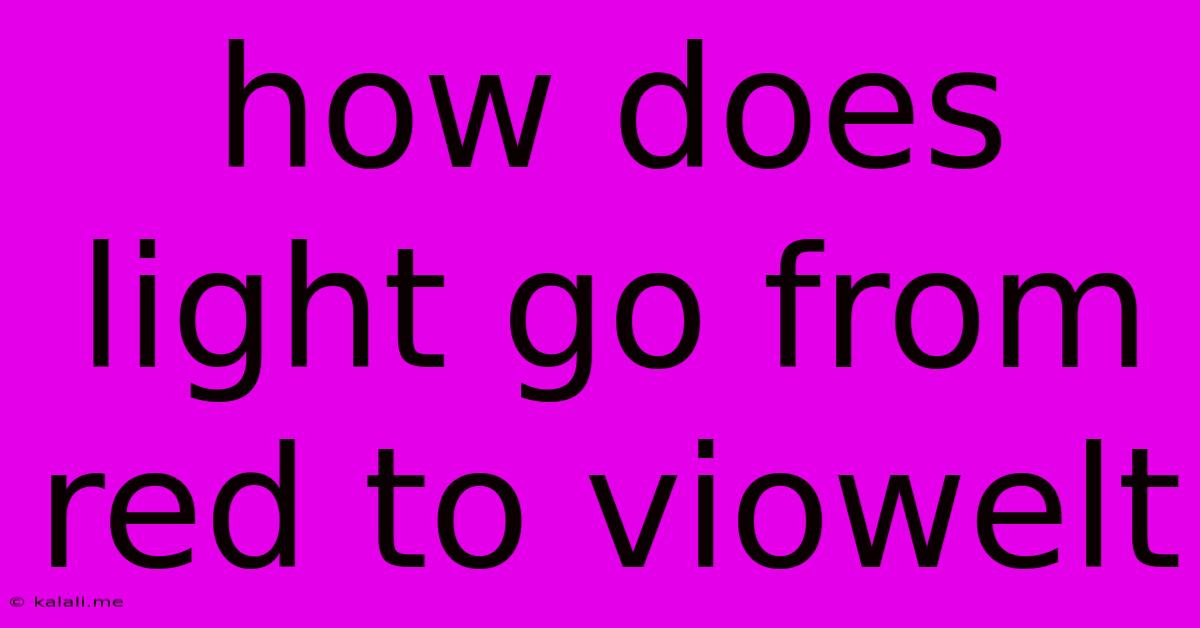How Does Light Go From Red To Viowelt
Kalali
Jun 08, 2025 · 3 min read

Table of Contents
How Does Light Go From Red to Violet? Understanding the Electromagnetic Spectrum
Have you ever wondered why a rainbow displays such a vibrant array of colors, smoothly transitioning from red to violet? The answer lies in the fascinating world of the electromagnetic spectrum and the properties of light itself. This article explores the physics behind this beautiful phenomenon, explaining how light's wavelength determines its color and how this creates the continuous spectrum we observe.
Light, as we perceive it, is actually a small portion of a much larger spectrum of electromagnetic radiation. This spectrum encompasses various forms of energy, including radio waves, microwaves, infrared radiation, visible light, ultraviolet radiation, X-rays, and gamma rays. These types of radiation differ primarily in their wavelength and frequency.
The Wavelength-Color Relationship
The key to understanding the red-to-violet transition is the relationship between light's wavelength and its perceived color. Visible light, the portion we can see, consists of wavelengths ranging from approximately 400 nanometers (nm) to 700 nm.
- Longer wavelengths (around 700 nm) correspond to red light.
- Shorter wavelengths (around 400 nm) correspond to violet light.
The colors in between – orange, yellow, green, blue, and indigo – represent the intermediate wavelengths. This continuous spectrum arises because light can exist at any wavelength within this range, leading to a smooth gradation of color.
How We See Color
Our eyes contain specialized cells called cones that are sensitive to different wavelengths of light. These cones respond to the different wavelengths, sending signals to our brains that we interpret as color. The combination of signals from these cones allows us to perceive the full range of colors within the visible spectrum.
Prisms and Rainbows: Separating the Colors
A prism, or even raindrops in the case of a rainbow, acts as a natural light disperser. As white light (which is actually a mixture of all visible wavelengths) passes through a prism, it's refracted (bent) at different angles depending on its wavelength. Longer wavelengths (red) are bent less, while shorter wavelengths (violet) are bent more. This separation of wavelengths results in the visible spectrum, with red on one end and violet on the other.
Beyond the Visible Spectrum
It's important to remember that the visible spectrum is just a small part of the larger electromagnetic spectrum. While we can't see them, wavelengths beyond the visible range exist and have important applications in various fields. For example:
- Infrared radiation is used in thermal imaging.
- Ultraviolet radiation is used in sterilization and medical treatments.
- X-rays are used in medical imaging.
Conclusion
The transition from red to violet in the visible light spectrum is a beautiful demonstration of the fundamental properties of light and its interaction with matter. Understanding the relationship between wavelength, frequency, and color helps us appreciate the complexities of the electromagnetic spectrum and the rich diversity of colors in the world around us. This knowledge has wide-ranging applications in fields from astronomy to photography and materials science.
Latest Posts
Latest Posts
-
How To Tell What Speed Your Bike Is
Jun 08, 2025
-
How To Fix A Leaking Aquarium Without Draining
Jun 08, 2025
-
How To Rid Gophers And Moles
Jun 08, 2025
-
How Do I Unsubscribe From Facebook
Jun 08, 2025
-
Can Forget Me Not Plant Be Planted Hydroponically Indoors
Jun 08, 2025
Related Post
Thank you for visiting our website which covers about How Does Light Go From Red To Viowelt . We hope the information provided has been useful to you. Feel free to contact us if you have any questions or need further assistance. See you next time and don't miss to bookmark.